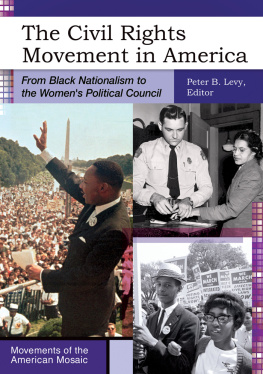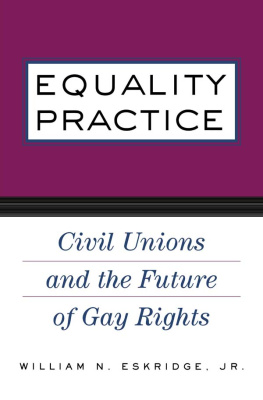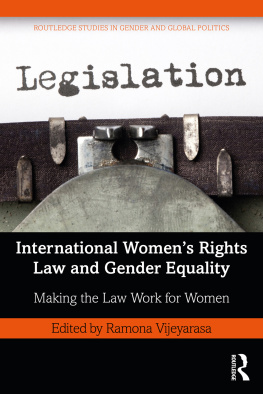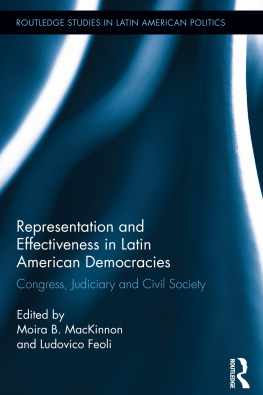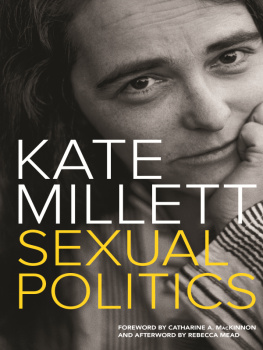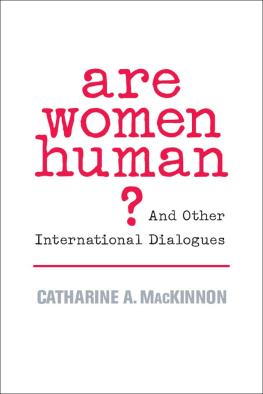Catharine A MacKinnon - Pornography and Civil Rights: A New Day for Womens Equality
Here you can read online Catharine A MacKinnon - Pornography and Civil Rights: A New Day for Womens Equality full text of the book (entire story) in english for free. Download pdf and epub, get meaning, cover and reviews about this ebook. City: Minneapolis, Minn, year: 1989, publisher: Organizing Against Pornography, genre: Home and family. Description of the work, (preface) as well as reviews are available. Best literature library LitArk.com created for fans of good reading and offers a wide selection of genres:
Romance novel
Science fiction
Adventure
Detective
Science
History
Home and family
Prose
Art
Politics
Computer
Non-fiction
Religion
Business
Children
Humor
Choose a favorite category and find really read worthwhile books. Enjoy immersion in the world of imagination, feel the emotions of the characters or learn something new for yourself, make an fascinating discovery.

- Book:Pornography and Civil Rights: A New Day for Womens Equality
- Author:
- Publisher:Organizing Against Pornography
- Genre:
- Year:1989
- City:Minneapolis, Minn
- Rating:4 / 5
- Favourites:Add to favourites
- Your mark:
- 80
- 1
- 2
- 3
- 4
- 5
Pornography and Civil Rights: A New Day for Womens Equality: summary, description and annotation
We offer to read an annotation, description, summary or preface (depends on what the author of the book "Pornography and Civil Rights: A New Day for Womens Equality" wrote himself). If you haven't found the necessary information about the book — write in the comments, we will try to find it.
Pornography and Civil Rights: A New Day for Womens Equality — read online for free the complete book (whole text) full work
Below is the text of the book, divided by pages. System saving the place of the last page read, allows you to conveniently read the book "Pornography and Civil Rights: A New Day for Womens Equality" online for free, without having to search again every time where you left off. Put a bookmark, and you can go to the page where you finished reading at any time.
Font size:
Interval:
Bookmark:
Pornography and Civil Rights
Law has traditionally considered pornography to be a question of private virtue and public morality, not personal injury and collective abuse. The law on pornography has been the law of morals regulation, not the law of public safety, personal security, or civil equality. When pornography is debated, in or out of court, the issue has been whether government should be in the business of making sure only nice things are said and seen about sex, not whether government should remedy the exploitation of the powerless for the profit and enjoyment of the powerful. Whether pornography is detrimental to the social fabric has therefore been considered; whether particular individuals or definable groups are hurt by it has not been, not really.
Since, in this traditional view, pornography can only violate an idea of the society one wants to think one lives in, the question of pornography has not required looking into who can violate whom and get away with it. Once pornography is framed as concept rather than practice, more thought than act, more in the head than in the world, its effects also necessarily appear both insubstantial and unsubstantiated, more abstract than real. So both what pornography is and what it does have been seen to lie in the eye of the beholder, to be a matter of what one is thinking about when one looks at it, to be a question of point of view. And since the accepted solution for differing moral views has been mutual tolerance, one mans harm has been seen as anothers social value as the pornography industry in the United States has doubled in the last ten years without effective interference from the courts.
The law has been wrong. Obscured beneath the legal fog of obscenity law and the shield of the law of privacy and the perversely cruel joke of the law against prostitution has been the real buying and selling of real individuals through coercion or entrapment, or through exploiting their powerlessness, social worthlessness and lack of choices and credibility, their despair and sometimes their hope. Shielded from public view, in-part through the collaboration of law, has been the manufacture from skin and blood and ruined lives of a vicious product by vicious people. Veiled as well has been the shameless profiteering in run-down parts of town, the pressure deals with unscrupulous politicians and judges, the arm-twisting of retailers, the takeovers of magazine distribution networks and underground control of legitimate entertainment businesses, the threats and sabotage of the personal, occupational, and public lives of anyone who gets in their way, and the outright buying of liberal credibility, which parades a traffic in human beingsthis auction block on every newsstand in the countryas a principled means of sexual and expressive freedom, and stigmatizes doing or saying anything about it as censorship.
Equally clouded by specious media reports and outright lies has been the direct evidence of a causal relationship between the consumption of pornography and increases in social levels of violence, hostility, and discrimination. So, few knew of those trapped in sexually toxic marriages or jobs to keep a roof over their heads and to feed their children. Fewexcept the many who did it or had it done to themknew that the abuses of pornographys production are a mere prelude to the abuse mass-produced through pornographys mass distribution and mass consumption: the rapes, the battery, the sexual harassment, the sexual abuse of children, the forced sex, the forced prostitution, the unwanted sexualization, the second-class status. And the increasing inability to tell the difference between all of that and sexall of that and just what a woman is.
Those who do this are silent in order to protect their power, profits, and pleasure. Many who have this done to them are silent because they are ashamed, afraid, bought, or dead. But overwhelmingly they are silent because even when they speak no one listens. This makes them ashamed and afraidand even, for all we know, bought or dead. For the rest, those who have known have not cared, and those who might have cared have not knownor were kept from knowing, or were not permitted to care, or thought they could not afford to know or care. Completely absent from most legal and political debate on the subject have been the twelve individual men whose names virtually never surface. These are the heads of large organized-crime families who own, control, and profit from the pornography industry, buying with terror whatever legitimacy and impunity they cannot buy with money, thriving while others pay the human cost. The entire debate over pornography is primarily for their benefit.
The legal conception of what pornography is has authoritatively shaped the social conception of what pornography does. Instead of recognizing the personal injuries and systemic harms of pornography, the law has told the society that pornography is a passive reflection or one-level-removed representation or symptomatic by-product or artifact of the real world. It thus becomes an idea analog to, a word or picture replay of, something else, which somehow makes what it presents, that something else, not real either. So its harms have not been seen as real. They have, in fact, been protected under the disguise of the name given that world of words and pictures which are not considered real: speech. This could happen because law is an instrument of social power first, and those who produce and consume pornography have social power. Pornography is made unreal to protect it, in order to protect the pleasure, sexual and financial, of those who derive its benefits. Those who are hurt by pornographysocietys powerless, its disregarded, its rejects, the invisible and voice less, mostly women and childrenare made unreal in order to keep their abuse defined the way those who enjoy it define it: as sex. Particularly with women, whose social definition as inferior is a sexual one, victimization through pornography has been perceived as a natural state, not as victimization at all but as fitting and chosen. When they are thought to be paid for their exploitation, that both confirms that this is what they have to sell and, by making it a market transaction, makes it appear not to be exploitation at all.
Law is often thought to be a neutral instrument. But law has participated directly in making pornography a legal and social institution. Obscenity law misdefines the problem of pornography as offensive and. immoral public displays of sex, evades the real harms, and is unworkable in design, while always making it seem that the problem could be solved with greater exercise of prosecutorial will. It is the seductiveness of obscenity law to seem potentially effective because its terms are so meaningless they could mean almost anything. As a result, they have meant almost nothing, being (actually) dependent upon the viewpoint of the observer. This makes obscenity law less useful the more pornography is a problem, because the more pornography is consumed, the more observers views are shaped by it, and the more the world it makes confirms that view. Privacy law has further institutionalized pornography by shielding the sexual sphere, where so much of pornographys violence to women is done, including by outright guaranteeing the right to possess pornography in the home, the most violent place for women. Pornography has also been legally institutionalized through decrying but permitting pimping and prostitution (of which pornography is one form), making sure prostitutes are the ones who pay for doing what the entire social system has given them, as women, little choice but to do in one form or another.
The law has helped make pornography a social institution more indirectly as well. The law of rape makes the pornographic assumption that women may consent to forced sex. The law of child custody applies the pornographic definition of the female to mothers. Women who have sexual relations with a man or men not the father of their children have long been considered loose women, hence not good mothers. Lesbian mothers have found that a woman who is not being sexually used by a man is considered an inadequate woman, hence also not a good mother. The frequent failures of attempts under sex-discrimination law to get women the same pay as men when they do different work of comparable value permits job definitions and pay scales to continue based on pornographic definitions of womens proper role as mens hierarchical subordinates, as sexually pleasing to men visually, and as servicers of male needs. It also keeps women so poor they need to sell sex to men to survive. The law of evidence pervasively permits a womans credibility to be based upon the pornographic standard that what a woman is sexually and does sexually is the relevant measure of her word and her worth. If she has had sex, she is worthless as a human being and can neither be violated nor believed. If she has not had sex, she is worthless as a woman, hence is not worthy of belief. Pervasively, whether by the collaboration of ineffective or perverse action, or by the complicity of inaction, the legal system has supported the existence and burgeoning of this industry and its social propriety as well. Deep legal echos on all levels of the system support the existence of pornography in the world and make it seem right that the legal system condones it. What the law does, the law must undo.
Next pageFont size:
Interval:
Bookmark:
Similar books «Pornography and Civil Rights: A New Day for Womens Equality»
Look at similar books to Pornography and Civil Rights: A New Day for Womens Equality. We have selected literature similar in name and meaning in the hope of providing readers with more options to find new, interesting, not yet read works.
Discussion, reviews of the book Pornography and Civil Rights: A New Day for Womens Equality and just readers' own opinions. Leave your comments, write what you think about the work, its meaning or the main characters. Specify what exactly you liked and what you didn't like, and why you think so.

